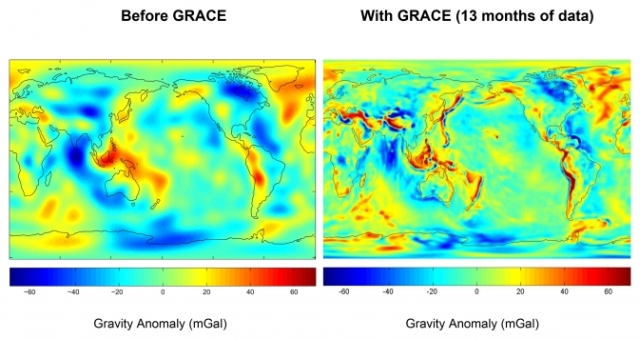Nov 8 2013
NASA technologists working to advance a pioneering technology that promises to detect tiny perturbations in the curvature of space-time now want to apply the same technique to map variations in Earth's gravity field.
 Knowledge of Earth's gravity field formerly was based on data from geodetic satellites (left). GRACE data is more than 100 times more accurate, characterizing how Earth's gravity field varies over time and space (right). Data from emerging atom-optics technology may be even more accurate. Image Credit: NASA
Knowledge of Earth's gravity field formerly was based on data from geodetic satellites (left). GRACE data is more than 100 times more accurate, characterizing how Earth's gravity field varies over time and space (right). Data from emerging atom-optics technology may be even more accurate. Image Credit: NASA
The NASA Innovative Advanced Concepts or NIAC program, which funds high-risk, potentially revolutionary technologies, recently awarded Phase-2 funding to Babak Saif, a technologist at NASA's Goddard Space Flight Center in Greenbelt, Md., and his team to continue developing an atom interferometer. With its potential picometer-level sensitivity, the instrument may one day detect what so far has remained imperceptible: gravitational waves or ripples in space-time caused when massive celestial objects move and disrupt the space around them.
However, detecting these infinitesimally small ripples — predicted by famed physicist Albert Einstein, but never directly observed — isn't the only application for the technology, said Bernie Seery, a Goddard executive who was instrumental in establishing Goddard's strategic alliance with Stanford University in Stanford, Calif., and AOSense Inc. in Sunnyvale, Calif. Both have received Defense Advanced Research Projects Agency (DARPA) funding to build and ruggedize atom optics-based sensors for a number of terrestrial applications.
The Goddard team now believes the technology also is ideal for geodesy, the science of measuring and monitoring Earth's size, shape and gravitational field.
More Powerful Interferometer
At its core, atom interferometry works much like optical interferometry, a 200-year-old technique widely used in science and industry to measure small displacements in objects. It obtains measurements by comparing light that has been split into two equal halves. Because the path that one beam travels is fixed in length and the other travels an extra distance or in some other slightly different way, the two light beams overlap and interfere when they meet up, creating an interference pattern that scientists inspect to obtain highly precise measurements.
Atom interferometry, however, hinges on quantum mechanics, the theory that describes how matter behaves at sub-microscopic scales. Just as waves of light can act like particles called photons, atoms can be cajoled into acting like waves if cooled to near absolute zero. At those frigid temperatures, which scientists achieve by firing a laser at the atom, its velocity slows to nearly zero. By firing another series of laser pulses at laser-cooled atoms, scientists put them into what they call a "superposition of states."
In other words, the atoms have different momenta permitting them to separate spatially and be manipulated to fly along different trajectories. Eventually, they cross paths and recombine at the detector, just as with a traditional interferometer. The power of atom interferometry is its precision. If the path an atom takes varies by even a picometer, an atom interferometer would be able to detect the difference.
Goddard Eyes Geodesy Application
With this level of precision, the technology could not only map Earth's gravitational field, which appears lumpy due to the uneven distribution of mass, but also chart how it changes over time.
"The gravitational field changes because of lots of reasons, including the influences of the sun and moon, but the most significant is due to the change in water mass, which includes Earth's ice sheets, oceans, ground water, lakes and rivers," said Scott Luthcke, a Goddard Planetary Geodynamics Laboratory scientist, who is working on the application. "If a glacier or ice sheet melts, this will affect mass distribution, and therefore, Earth's gravitational field."
By gathering both spatial and temporal measurements, scientists have another tool for studying Earth's response to climate change, he added. "In essence, you capture the Earth's mass changing in fine detail and over time."
Using Goddard research-and-development program funding, the team is adapting an atom optics-based gravity gradiometer that AOSense has developed primarily for terrestrial purposes under DARPA funding.
The instrument, which the military currently is demonstrating in field trials under harsh environmental conditions, is up to three orders-of-magnitude more sensitive than comparable technology. Once modified for use in a microgravity environment, it could potentially succeed NASA's Gravity Recovery and Climate Experiment or GRACE, a two-satellite mission that has generated since its launch in 2002 monthly gravity maps showing how mass is distributed and how it changes over time, Seery said.
"This unique sensor is capable of significantly improved spatial resolution and greater accuracy detecting surface-mass changes, eliminating the need for a two-satellite system, as with GRACE. Consequently, we could choose to save money by deploying only one satellite or we could opt for even greater accuracy by deploying a second in a complimentary orbit," Luthcke added. "This technology is a significant step forward and would provide an extraordinary data set for understanding Earth's water cycle and its response to climate change."
For more NASA Goddard technology news, visit: gsfctechnology.gsfc.nasa.gov